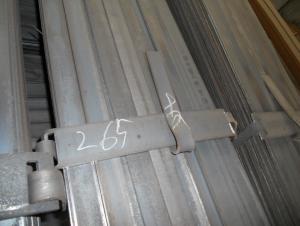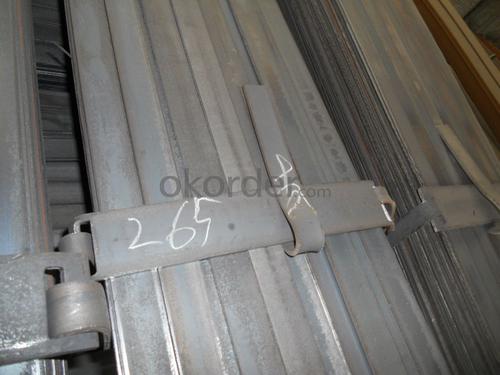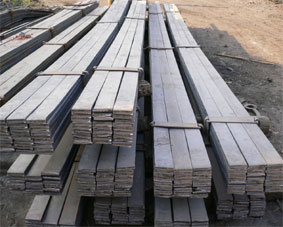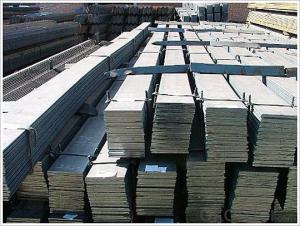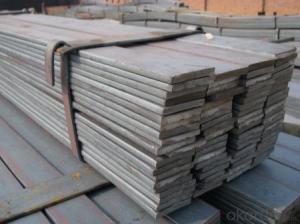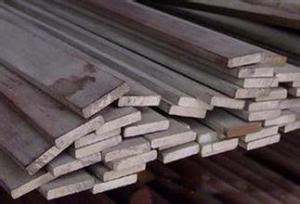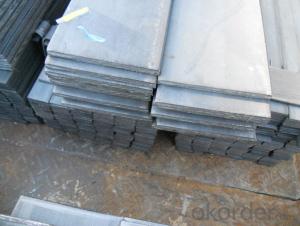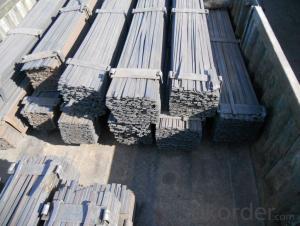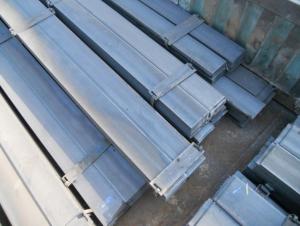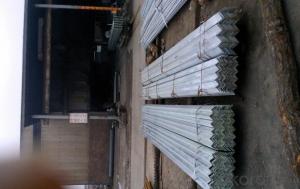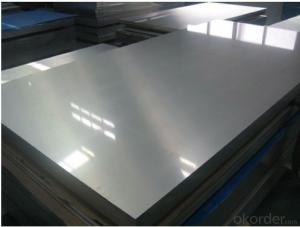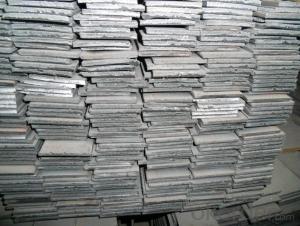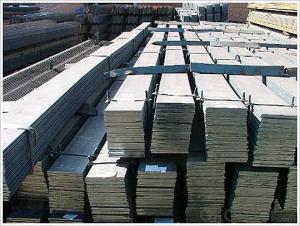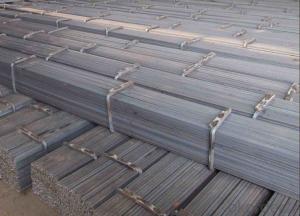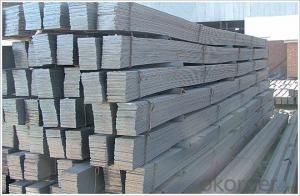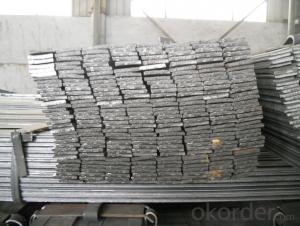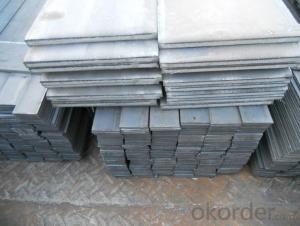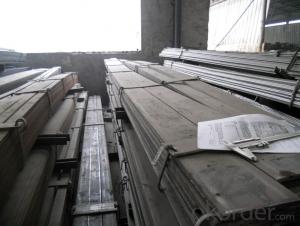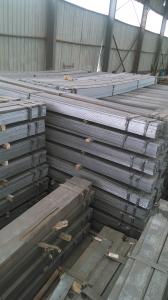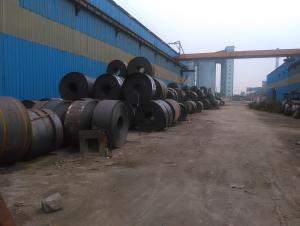Low Carbon Steel Flat Iron bars in High Quality
- Loading Port:
- China Main Port
- Payment Terms:
- TT or LC
- Min Order Qty:
- 100 m.t.
- Supply Capability:
- 10000 m.t./month
OKorder Service Pledge
OKorder Financial Service
You Might Also Like
OKorder is offering Low Carbon Steel Flat Iron bars in High Quality at great prices with worldwide shipping. Our supplier is a world-class manufacturer of steel, with our products utilized the world over. OKorder annually supplies products to African, South American and Asian markets. We provide quotations within 24 hours of receiving an inquiry and guarantee competitive prices.
Product Applications:
Low Carbon Steel Flat Iron bars in High Quality are ideal for structural applications and are widely used in the construction of buildings and bridges, and the manufacturing, petrochemical, and transportation industries.
Product Advantages:
OKorder's Low Carbon Steel Flat Iron bars in High Quality are durable, strong, and wide variety of sizes.
Main Product Features:
· Premium quality
· Prompt delivery & seaworthy packing (30 days after receiving deposit)
· Can be recycled and reused
· Mill test certification
· Professional Service
· Competitive pricing
Product Specifications:
Manufacture: slited
Slitting precision (width) : 0.5 mm or less
Raw material: Q235B, Q345B, Q235-1 b
crosscutting precision (length) : 2 mm or less
Processing: the thickness of 2.0-16 mm;
Shear length: 2000 mm above
Wide degree: 15-1250 - mm;
Leveling precision: 1-2 MM square
Packaging: Export packing, nude packing, bundled
FAQ:
Q1: Why buy Materials & Equipment from OKorder.com?
A1: All products offered byOKorder.com are carefully selected from China's most reliable manufacturing enterprises. Through its ISO certifications, OKorder.com adheres to the highest standards and a commitment to supply chain safety and customer satisfaction.
Q2: How do we guarantee the quality of our products?
A2: We have established an advanced quality management system which conducts strict quality tests at every step, from raw materials to the final product. At the same time, we provide extensive follow-up service assurances as required.
Q3: How soon can we receive the product after purchase?
A3: Within three days of placing an order, we will arrange production. The normal sizes with the normal grade can be produced within one month. The specific shipping date is dependent upon international and government factors, the delivery to international main port about 45-60days.
Images:
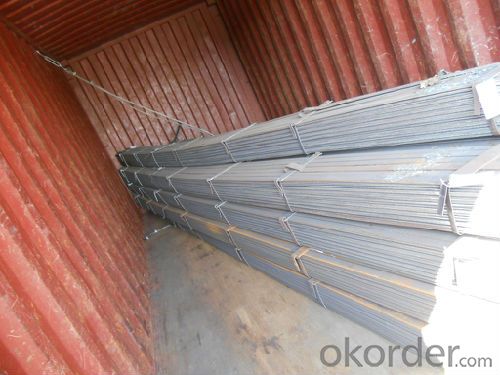
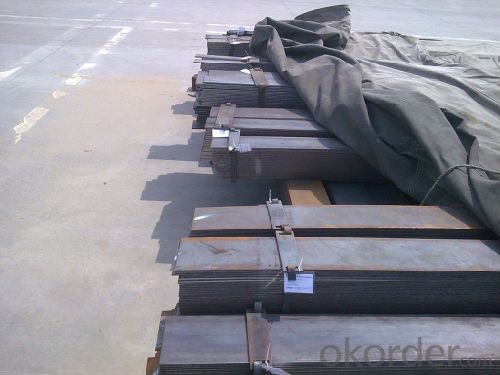
- Q: Are steel flat bars suitable for making industrial equipment?
- Steel flat bars are well-suited for the production of industrial equipment. Renowned for their strength, durability, and versatility, these bars are highly suitable for a range of applications within the industrial sector. They can be utilized to create frames, supports, and structures for machinery and equipment. Furthermore, steel flat bars possess exceptional load-bearing capabilities, making them an ideal choice for heavy-duty industrial equipment. Moreover, their ease of welding, cutting, and shaping enables them to be tailored to specific design requirements, allowing for customization and flexibility in equipment manufacturing. Overall, steel flat bars are a dependable and extensively utilized material in the fabrication of industrial equipment, owing to their robustness, longevity, and adaptability.
- Q: How do you calculate the weight of a steel flat bar?
- To calculate the weight of a steel flat bar, you need to know the dimensions of the bar and the density of steel. First, measure the length, width, and thickness of the flat bar in inches or any other unit of measurement. Next, calculate the volume of the bar by multiplying the length, width, and thickness. The formula for volume is: Volume = Length x Width x Thickness. After obtaining the volume, convert it to cubic inches if needed. Then, determine the density of steel, which is typically measured in pounds per cubic inch (lbs/in³). The density of steel can vary slightly depending on the specific alloy, but a commonly used value is 0.2836 lbs/in³. Finally, multiply the volume of the flat bar by the density of steel to calculate the weight. The formula for weight is: Weight = Volume x Density. For example, if the dimensions of the steel flat bar are 12 inches in length, 2 inches in width, and 0.5 inches in thickness, the volume would be 12 x 2 x 0.5 = 12 cubic inches. Assuming the density of steel is 0.2836 lbs/in³, the weight of the steel flat bar would be 12 x 0.2836 = 3.4032 lbs. Therefore, the weight of the steel flat bar would be approximately 3.4 pounds.
- Q: How do steel flat bars perform under impact or shock-loading conditions?
- Steel flat bars exhibit excellent performance when subjected to impact or shock-loading due to their exceptional strength and durability. The inherent characteristics of steel, including its high tensile strength and resilience, render it an optimal material for withstanding abrupt and forceful impacts. When faced with impact or shock-loading, steel flat bars possess the capability to absorb and distribute the energy uniformly throughout their structure. This capacity helps to avert localized failure and guarantees the even dispersion of the force. Consequently, steel flat bars are less prone to deformation, fracture, or breakage under these circumstances. Moreover, steel showcases remarkable resistance to fatigue, thereby enabling it to endure repetitive impacts without experiencing significant deterioration in its performance. This quality makes steel flat bars highly suitable for applications where dynamic loads or sudden impacts are prevalent, such as in the realms of construction, automotive manufacturing, or industrial machinery. Nevertheless, it is essential to acknowledge that the specific performance of steel flat bars under impact or shock-loading conditions may vary depending on several factors, including the quality of the steel utilized, the dimensions of the flat bar, and the particular application involved. Hence, it is crucial to carefully consider the specific requirements and seek guidance from experts or engineers to ensure the appropriate steel grade and design are employed for the intended purpose.
- Q: Are steel flat bars suitable for handrail applications?
- Yes, steel flat bars are suitable for handrail applications. Steel flat bars are strong and durable, making them an excellent choice for handrails. They can provide stability and support while also offering a sleek and modern aesthetic. Additionally, steel flat bars are versatile and can be easily customized to fit various handrail designs. They can be painted or coated to enhance their corrosion resistance and can withstand heavy use and constant contact. Overall, steel flat bars are a cost-effective and reliable option for handrail applications.
- Q: How do steel flat bars contribute to the earthquake resistance of buildings?
- Steel flat bars contribute to the earthquake resistance of buildings by providing additional strength and stiffness to the structure. When used as reinforcements or bracing elements, they help distribute and absorb the forces generated during an earthquake, reducing the risk of structural failure. Additionally, steel flat bars enhance the overall stability of the building, minimizing deformation and improving its ability to withstand ground shaking.
- Q: How do you cut a steel flat bar?
- To cut a steel flat bar, you will need the following tools: a metal cutting saw, a clamp or vice to secure the bar, and safety equipment such as gloves and goggles. Here's a step-by-step guide on how to cut a steel flat bar: 1. Measure and mark the desired length of the steel flat bar using a measuring tape and a marker. Make sure the marks are clearly visible. 2. Secure the steel flat bar in a clamp or vice, ensuring that it is tightly held and won't move during the cutting process. This will provide stability and prevent any accidental movements. 3. Put on safety gloves and goggles to protect yourself from any flying metal fragments or sparks. 4. Position the metal cutting saw perpendicular to the steel flat bar, aligning it with the marked cutting line. 5. Start the saw and slowly guide the blade into the steel flat bar, applying steady and even pressure. Let the saw do the cutting work; avoid forcing or pushing too hard, as this can damage the saw blade or cause the steel to overheat. 6. Continue cutting until you reach the marked cutting line. Take breaks periodically to allow the steel to cool down if needed, as excessive heat can affect the cutting process. 7. Once the cut is complete, turn off the saw and inspect the steel flat bar for any rough edges or burrs. Use a metal file or sandpaper to smooth out any imperfections. 8. Finally, remove the steel flat bar from the clamp or vice and clean up the work area, ensuring all metal shavings are properly disposed of. Remember to exercise caution and follow proper safety protocols when cutting steel, as it can be sharp and produce sparks. If you are unsure or lack experience, it is advisable to seek assistance from a professional or consult a metalworking specialist.
- Q: Can steel flat bars be used for making brackets or supports for plumbing systems?
- Indeed, brackets or supports for plumbing systems can be made using steel flat bars. Within construction and plumbing, steel is widely utilized due to its robustness and longevity. Opting for steel flat bars offers a dependable and strong solution, capable of effectively supporting the weight of plumbing pipes and fixtures. Furthermore, steel exhibits resistance against corrosion, rendering it appropriate for deployment in damp settings like plumbing systems. All things considered, steel flat bars serve as a fitting selection for fabricating brackets or supports for plumbing systems.
- Q: How do steel flat bars perform in high-humidity environments?
- Steel flat bars generally perform well in high-humidity environments, but their performance can be affected by certain factors. Steel is known for its strength, durability, and corrosion resistance, which makes it suitable for various applications. However, in high-humidity environments, the presence of moisture can accelerate the corrosion process, potentially causing rust and deterioration of the steel. To mitigate the effects of high humidity, steel flat bars can be coated with protective finishes or treated with corrosion-resistant coatings such as galvanization. These coatings create a barrier between the steel and the surrounding environment, preventing or slowing down the corrosion process. However, it is important to note that the effectiveness of these coatings can vary depending on the quality of the coating and the severity of the humidity. In extremely humid or corrosive environments, it may be necessary to use stainless steel flat bars, which have a higher resistance to corrosion. Regular maintenance and inspection are also crucial in high-humidity environments to identify any signs of corrosion or damage early on. This can involve cleaning the steel regularly, removing any accumulated moisture or debris, and applying additional protective coatings if necessary. Overall, while steel flat bars can perform well in high-humidity environments, it is essential to consider the specific conditions and take appropriate measures to ensure their long-term durability and performance.
- Q: Lightning protection grounding, what is called three surface welding?
- Lightning protection, grounding, the three sides of the welding:The buried depth of the grounding body shall not be less than 1m at the top, and the steel pipe grounding body shall be vertically configured.The length of the vertical grounding body shall not be less than 2.5m, and the spacing between them shall not be less than 5m.
- Q: What are the different packaging options for steel flat bars?
- The different packaging options for steel flat bars can vary depending on the supplier and specific requirements. Common packaging options include bundles, wooden crates, or steel racks. Bundles are typically wrapped in plastic or steel straps to secure the bars together, while wooden crates provide additional protection during transportation. Steel racks are used for larger quantities and allow for easy loading and unloading of the flat bars.
Send your message to us
Low Carbon Steel Flat Iron bars in High Quality
- Loading Port:
- China Main Port
- Payment Terms:
- TT or LC
- Min Order Qty:
- 100 m.t.
- Supply Capability:
- 10000 m.t./month
OKorder Service Pledge
OKorder Financial Service
Similar products
Hot products
Hot Searches
Related keywords
